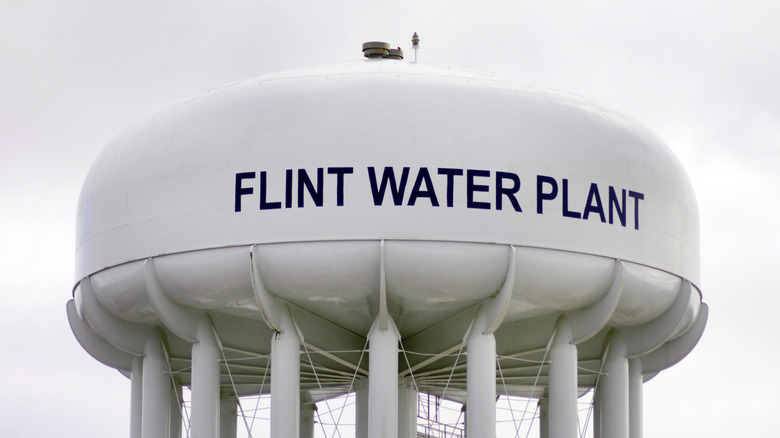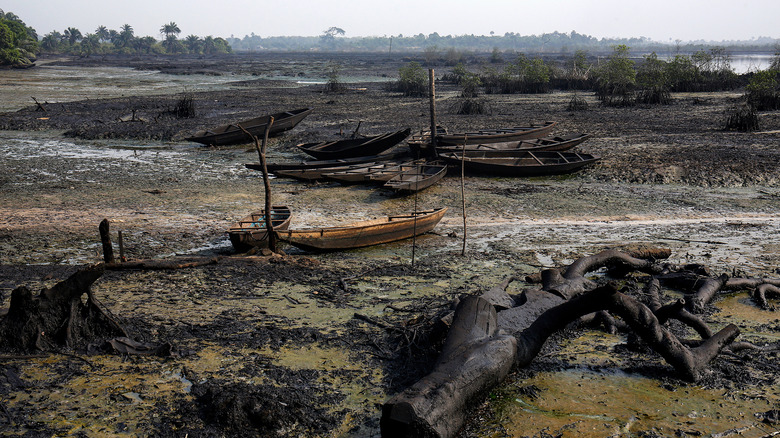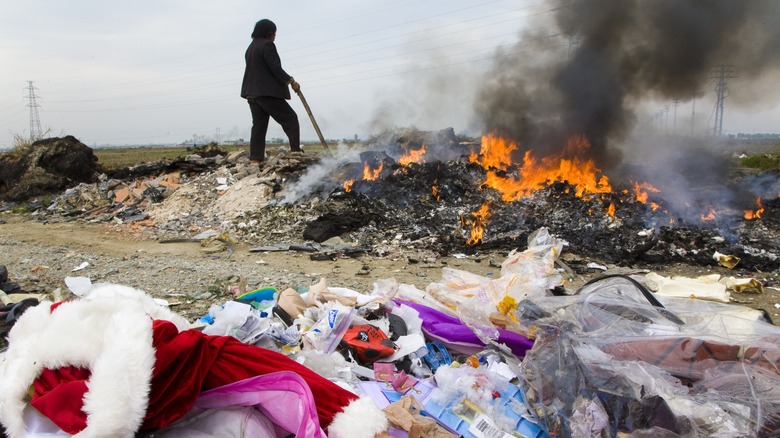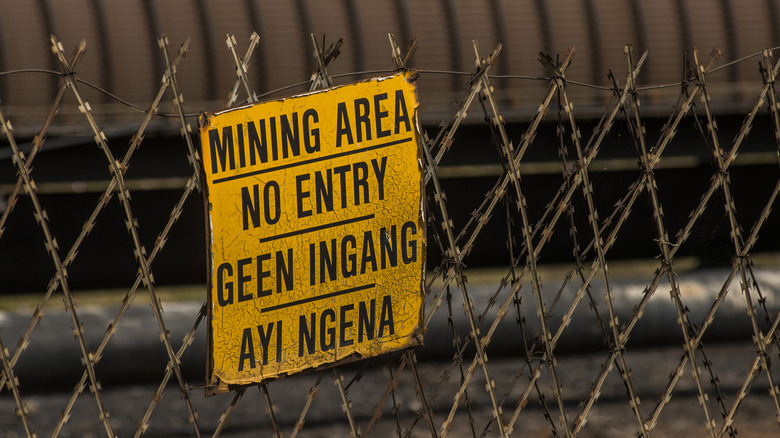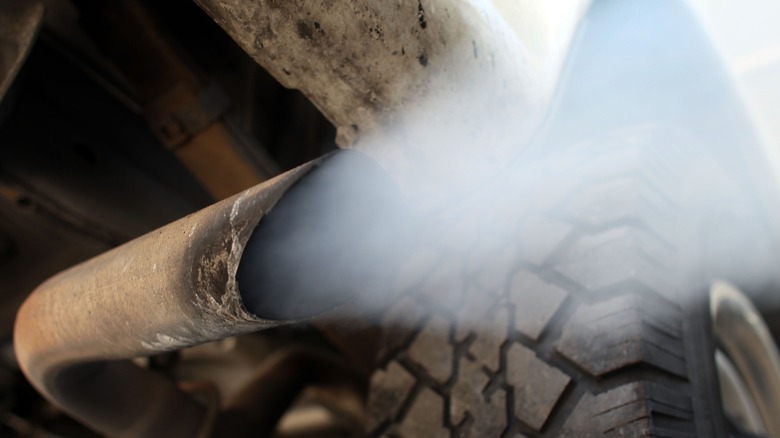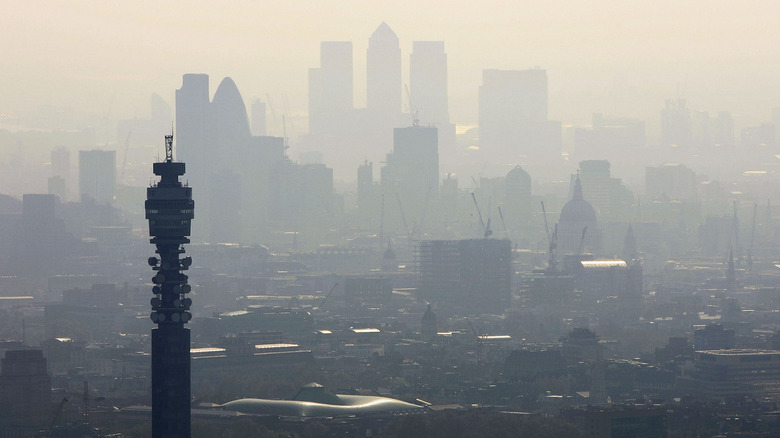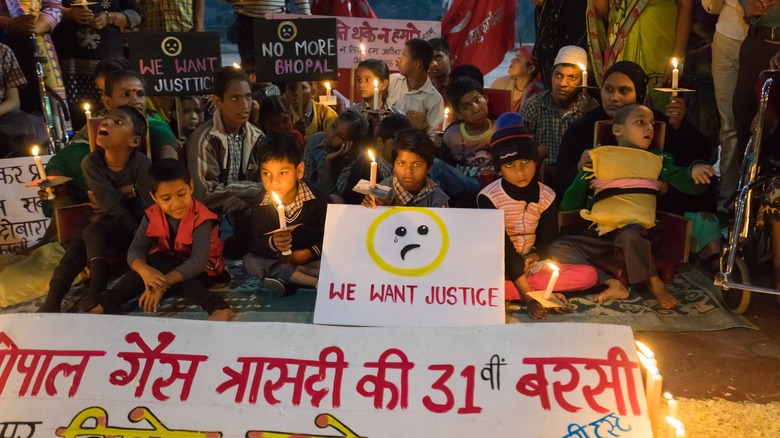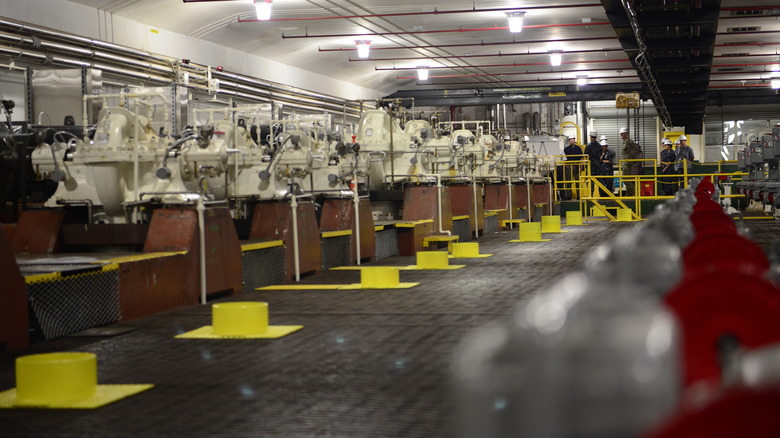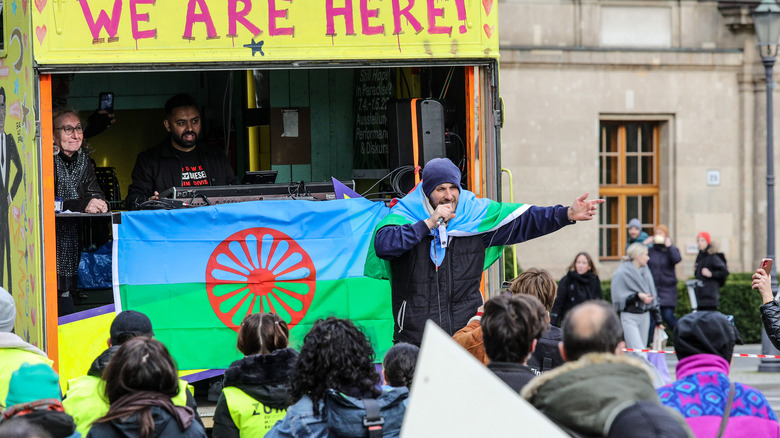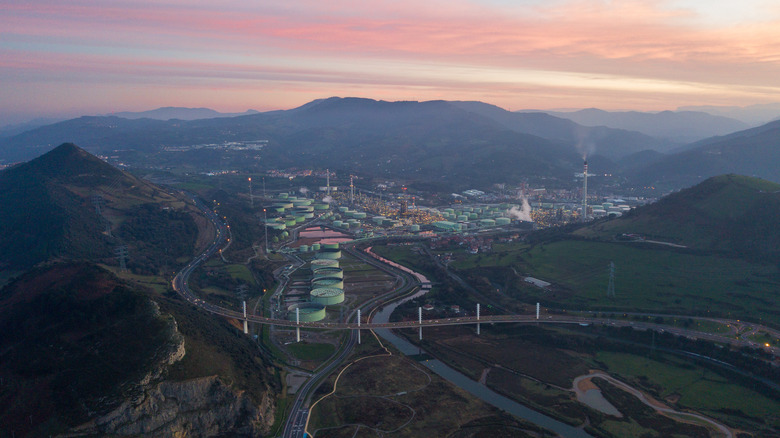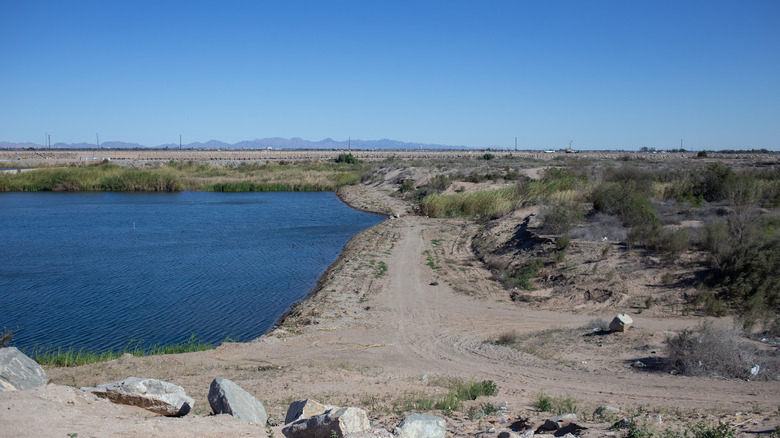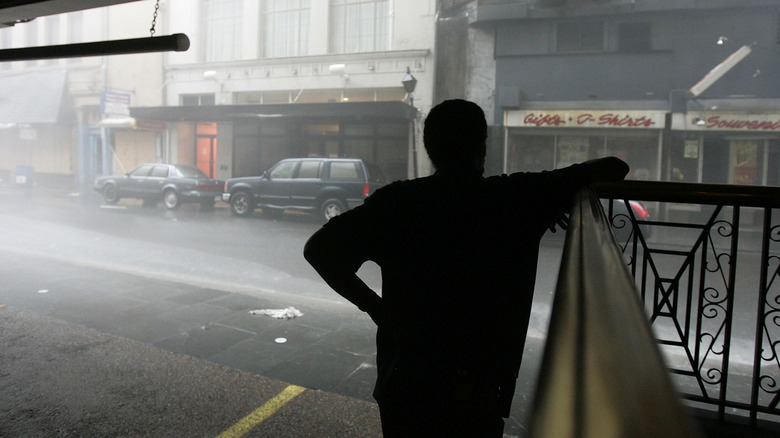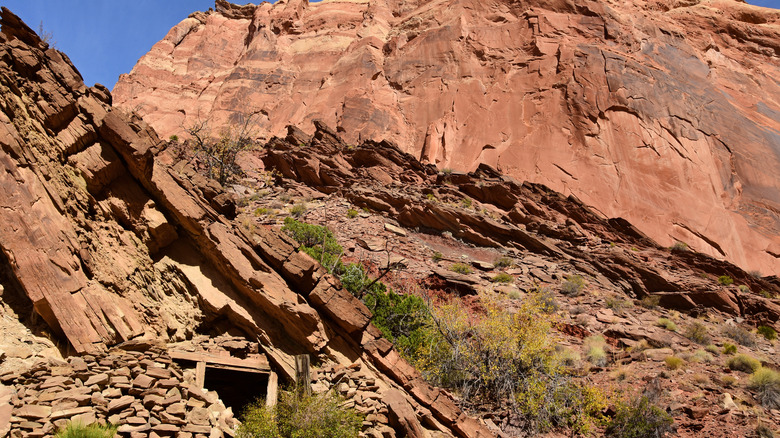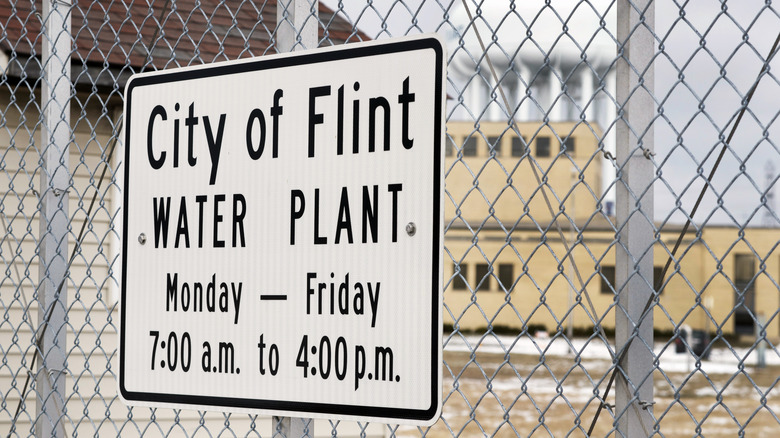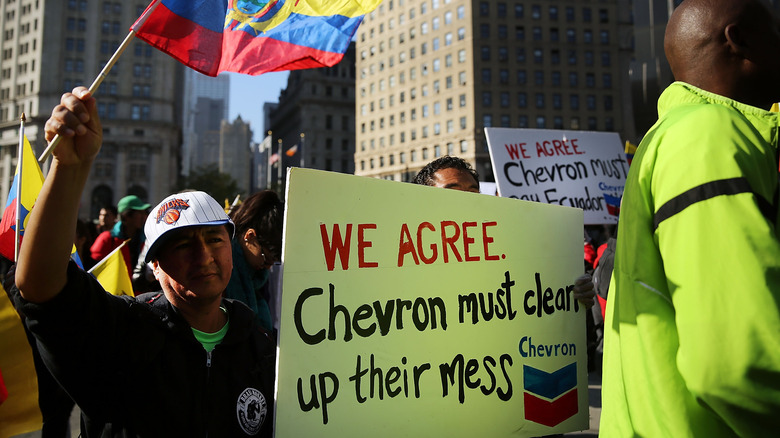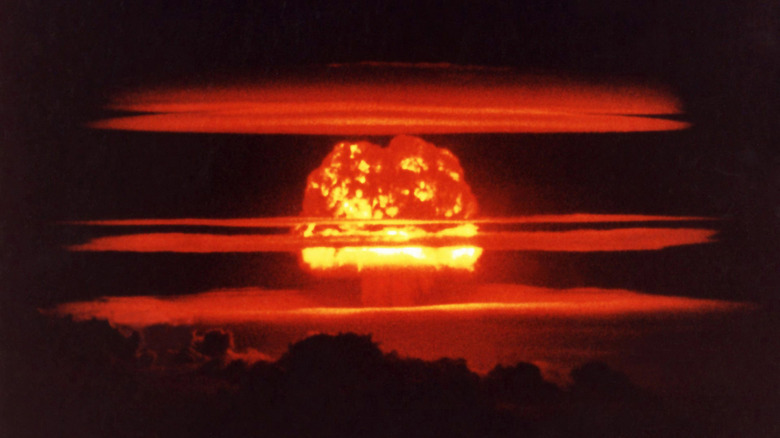The Worst Examples Of Environmental Racism In History
We may receive a commission on purchases made from links.
As climate change begins to have more and more drastic effects on weather patterns, it's important to recognize that not everyone in the world will feel the effects of climate change equally. Because of systemic inequalities that are based around racism and classism, some communities will end up facing the brunt of environmental catastrophes.
This disparity isn't limited to climate change. In accordance with a white supremacist, colonialist, and capitalist mentality, Indigenous people and people of color are often the first to be exploited and most likely to disproportionately suffer the negative environmental effects, known as environmental racism. This also includes government or corporate involvement that deliberately targets communities "for locally undesirable land uses and lax enforcement of zoning and environmental laws, resulting in communities being disproportionately exposed to toxic and hazardous waste," according to the non-profit Greenaction.
Unless a drastic effort is made, examples of environmental racism are only going to grow. And considering how many instances of environmental racism are built upon years of racist policies, it'll take more than a policy change to make a difference. These are the worst examples of environmental racism in history.
Oil extraction in Nigeria
For over half a century, oil and gas companies have caused widespread contamination in the Niger Delta. But whenever people try to hold these companies responsible for their actions, the companies refuse to admit liability and it becomes "nearly impossible to hold them accountable in Nigerian courts," writes The Guardian.
One company that's responsible for a majority of the spills in Ogoniland is Shell, which is responsible for roughly half of Nigeria's oil production and caused over 100 spills in Nigeria in 2021 alone. And according to "The Environmental Justice Reader," edited by Mei Mei Evans, Rachel Stein, and Joni Adamson, it's estimated that "40% of Shell's oil spills worldwide have occurred in Nigeria, suggesting that Shell maintains a lower environmental standard there than elsewhere." CorpWatch writes that Shell has also been accused of dumping toxic waste in abandoned oil wells, leading to many people falling ill and dying in the surrounding area.
In 2019, the Nigerian Tribute reported that the Environmental Rights Action (ERA) directly accused oil corporations operating in the Niger Delta of environmental racism, including Shell, for the double standard they follow when operating in non-European countries. Godwin Ojo, one of the founders of ERA, has said that the problems in the Niger Delta have escalated "because Shell did not keep to its own regulations. Neither did Shell keep to Nigerian law. Why does Shell need our government to make them keep to their own rules?"
Sending waste abroad
For almost 30 years, Western countries sent most of their trash to China to be destroyed or recycled. Most of the electronic trash was sent to the city of Guiyu, China and until 2013, Guiyu was the largest e-waste dump in the world, according to Environment & Society Portal, Arcadia. The use of Guiyu as a dumping ground for e-waste had severe effects on the health of Guiyu's residents. In 2007, US News & World Report reported that approximately 80% of children in Guiyu suffered from lead poisoning. In 2019, it was also revealed that Western countries would often send trash to countries like Malaysia illegally by falsely declaring the trash as other imports.
Between 1992 and 2018, China was responsible for importing almost half of the world's total trash. But after instituting a ban on 24 types of foreign trash, according to the Journal of Material Cycles and Waste Management, the amount of imported plastic alone to China dropped from 5.83 million tons in 2017 to 51,605 tons in 2018. Brown Political Review writes that Malaysia, Thailand, Cambodia, Vietnam, and Indonesia have also joined the movement to ban trash imports, pushing back against Western exploitation of countries without environmental regulations.
Unable to deal with its own trash, The Guardian reports that the United States exports up to 68,000 shipping containers worth of plastic recycling every year, and since China's ban on plastic imports, "America's plastic waste has become a global hot potato, ping-ponging from country to country."
South African mining
Despite the fact that apartheid in South Africa ended almost 30 years ago, much of the environmental racism that occurred in the coal mining industry during apartheid continues to have lingering effects into the 21st century. According to NYU, coal was once referred to as the economic foundation of apartheid. "As a replacement for international energy, domestic coal provided an affordable and easily accessible energy source through the use of cheap labor – Black workers."
In addition to Black workers being kept in poverty through low wages, poor Black and non-white communities were the ones exposed to hazardous waste dumping from the mines. In 2001, the rates of leukemia among Black people in Durban were 24-times higher than in other parts of the country. With no existing laws in the area covering air pollution, all the unregulated air pollution by the coal industry was turned onto the most vulnerable communities.
Since the end of apartheid, there have been few active changes. The Conversation writes that most Black South Africans don't have access to clean water or air and "continue to live on the most damaged land, in the most polluted neighborhoods near coal-fired power stations, steel mills, incinerators, and waste sites."
U.S. air pollution
It's estimated that between 100,000 and 200,000 deaths annually in the United States can be attributed to air pollution, but air pollution doesn't affect all populations uniformly. According to the Environmental Science & Technology Letters, non-white communities are "systematically exposed to higher levels of air pollution." This is influenced both by redlining, which largely affected Black and Hispanic Americans, as well as the lack of increased air pollution regulation benefits, which largely affects Native tribal communities in the United States.
Inverse reports that these "intentionally racist policies over time have contributed to the disproportionate air pollution burden in these communities of color." And when it comes to redlining, racial disparities were found even within redlined neighborhoods, with non-white people receiving more air pollution exposure than white people who also live in redlined neighborhoods. And according to the Harvard School of Public Health, as a result of air pollution and exposure to PM2.5, non-white people as well as people with lower incomes in general have a higher risk of premature death.
Air pollution in London
The United States isn't the only place where non-white people are subjected to higher levels of air pollution. According to The Guardian, Black, African, and Caribbean people make up over 15% of all Londoners that are exposed to illegally high levels of nitrogen dioxide despite the fact that they make up a little over 13% of London's population. And although cars contribute greatly to nitrogen dioxide pollution, communities with the fewest cars were subject to the highest levels of air pollution. As Environment and Planning A points out, "those communities that are most polluted and which also emit the least pollution tend to be amongst the poorest in Britain."
In 2013, 9-year-old Ella Adoo-Kissi-Debrah became the first person in London to officially die from air pollution. After dying from acute respiratory failure, a coroner ruled in 2020 that air pollution contributed to her death, reports Euronews. And in 2018, it was found that the air pollution levels just one mile away from Adoo-Kissi-Debrah's house "exceeded legal EU limits in the three years prior to her death." And during those three years, Adoo-Kissi-Debrah had been hospitalized with breathing issues almost 30 times.
Pesticides in India
Known as the "Hiroshima of the Chemical Age," the Bhopal gas tragedy is considered to be the worst industrial disaster in world history. After a gas leak at a pesticide plant in December 1984, over 600,000 people around Bhopal were exposed to methyl isocyanate (MIC) gas, causing at least 10,000 deaths, according to Spring Magazine, although with so many unidentified bodies, the actual death toll is likely even higher. Columbia Climate School writes that the death toll may have been as high as 20,000, with another 200,000 physically disabled as a result.
The pesticide plant was operated by Union Carbide, and later purchased by DOW Chemical after the accident, but according to Terra Daily, neither corporation has made any attempt to clean the pollution from the plant. The plant has also been dumping toxic waste at the site since it opened in 1969 and didn't bother warning the nearby communities about the chemicals that were leaking into the soil and water.
The Atlantic writes that although Union Carbide operated a sister plant in West Virginia, they didn't maintain any of the alarm systems and safety systems for their personnel in the India plant as they did in the United States. And even before the gas leaks, there were a number of accidents, some of which were fatal to workers. Meanwhile, over 30 years later, the groundwater remains contaminated in over 20 communities near Bhopal.
Red Hill fuel spill
After 27,000 gallons of jet fuel leaked from the U.S. military's Red Hill storage tanks in Kapūkaki, Hawai'i in 2014, the Navy claimed that they were going to work with state and federal regulators to make sure nothing like that ever happened again. But seven years later, it was revealed that not only was there another large spill but that the Navy had been allowing yearly leaks to occur.
According to Hawaii News Now, it's estimated that the Red Hill fuel tanks leak over 5,000 gallons of fuel per year, in addition to the 14,000 gallons of fuel that was spilled on November 20, 2021. But despite the fact that thousands of people fell ill and thousands of families were displaced as a result, it took the Navy weeks before they admitted that a spill from their facility was responsible.
Although the U.S. Department of Defense has said that it will permanently shut down Red Hill and defuel the facilities, writes Hawai'i Public Radio, the Navy has repeatedly delayed acting on orders to defuel so it's unclear when the facility will be shut down for good. Meanwhile, the Protect Kahoʻolawe ʻOhana organization has repeatedly maintained the danger that the fuel storage tanks present to the O'ahu aquifer and called for a complete shutdown, noting that the incidents at Red Hill fit the pattern the U.S. Navy has established by ignoring the rights of indigenous Hawaiians in favor of military objectives.
Roma in the EU
In 2020, a report conducted by the European Environmental Bureau found that Roma communities were often forced to live in some of the most polluted areas of Europe while simultaneously being deprived of essential services like clean running water. Al Jazeera writes that this was attributed to being a result of systemic environmental racism.
Many Roma people, also known as Romani, are reportedly subjected to forced evictions and often ended up living near landfills or contaminated industrial sites. In Stolipinovo, part of the Bulgarian city of Plovdiv, more than 60,000 Roma people living there have no access to public water or waste collection services.
Harvard International Review writes that many media sources and governing bodies in Europe reinforce the belief that Roma people choose to live in segregated societies. Meanwhile, it is often government authorities themselves who "routinely evict Roma communities to undesirable areas in the outskirts of cities, often landfills, to make room for new infrastructure projects and in an attempt to promote tourism."
Canada's Chemical Valley
In Canada, roughly 40% of the petrochemical industry is located in an area known as Chemical Valley near Sarnia, Ontario, and the Aamjiwnaang First Nation. Chemical Valley emits approximately 10% of Ontario's total emissions, more than 45,000 tonnes of air pollutants annually, Al Jazeera reports.
Surrounded by pollution, the Aamjiwnaang people are exposed to highly toxic levels of several pollutants. According to The Guardian, the level of carcinogenic chemicals in the air is 44 times higher than safe levels. As a result, stories of miscarriages, stillbirths, dialysis, and chemotherapy are common within the Aamjiwnaang community and Anishinabek News reports that between 2001 to 2012, four new cancers were reported every year in Aamjiwnaang on average.
Spills also happen frequently in the refineries in Chemical Valley. Between 2015 and 2017 alone, there were over 500 spills or leaks, according to "Local Activism for Global Climate Justice," edited by Patricia E. Perkins. Unfortunately, Indigenous people all over the world are subject to this kind of environmental racism. "Indigenous people globally were among the populations at highest risk of being affected by pollution, with oil and gas exploration, mineral extraction, toxic waste dumping and industrial development among the top sources of exposure."
Fishing in the Colorado River
Although the Cucapá are known as the River People, for years they're unable to access their ancestral river because the United States has it dammed at the international border with Mexico. The Cucapá have lived with and off the Colorado River for generations, but after the Glen Canyon dam was built in 1966, the river flow dropped dramatically.
According to The Guardian, any water that does make it into Mexico is diverted to irrigate farmland, and as a result the Cucapá are left without a river to fish in. Although some Cucapá have resorted to fishing in the open sea, this lifestyle is also being affected by illegal fishing, corruption, and the climate crisis. One local, Francisco Javier Gonzales said, "The [1944] treaty was catastrophic for us. We were never consulted and no one has apologized or compensated us for the way our lives have been drastically changed by losing the river. The Cucapá are river people, not sea people, but now we're being forced from the sea as well."
Intercontinental Cry also reports that armed Mexican marines and federal police have previously confiscated fish from the Cucapá under the charge of illegal fishing, with no acknowledgment of the Cucapá's dependence on fishing. Indigenous fishing communities also faced similar issues in the 1960s and 1970s, leading to what's known as the Fish Wars.
Hurricane Katrina
The fact that Hurricane Katrina was so devastating for so many people wasn't just an accident of nature. Black people in New Orleans were disproportionately affected by the hurricane as a direct result of racist housing practices, in addition to a lack of accessible evacuation policies. ESRI writes that because of racist lending practices that kept Black people from purchasing high-ground homes, minority communities in New Orleans lived in neighborhoods that were more susceptible to flooding. And with no accessible evacuation, Black people made up 93% of those stranded after the storm.
According to the Social Science Research Council, environmental justice advocates feared and anticipated the racially disproportionate effects of climate change, noting in 2002 that "people of color are concentrated in urban centers in the South, coastal regions, and areas with substandard air quality. New Orleans, which is 62% African-American and 2 feet below sea level, exemplifies the severe and disproportionate impacts of climate change in the U.S."
CEEJH also notes that this type of environmental racism isn't limited to Hurricane Katrina. After Hurricane Harvey hit Texas in 2017, a 2019 study found that neighborhoods of Black and Hispanic communities experienced the most flooding. This was also seen during Hurricane Sandy in New York in 2012.
Navajo people and uranium
Ever since the United States started mining uranium in the Navajo Nation in 1944, the Diné people have been subject to exploitation and discriminatory practices that left them with health problems while others profited. Not only were Diné people not told about the health risks of uranium, despite coming into contact with it daily as workers or families of workers, but after uranium mining ceased the mines were abandoned and over 500 uranium mines were left open, contaminating the air and water.
According to the House of Representative Hearings before the Subcommittee on Administrative Law and Governmental Relations, the Public Health Service decided that miners "would not be told of possible potential hazards from radiation in the mines for fears that many miners would quit and others would be difficult to secure because of fear of cancer."
In addition, the United States government was entirely negligible after the Church Rock mill spill, when the dam at the largest underground uranium mine in the United States burst, releasing over 93 million gallons of radioactive liquid into the Rio Puerco next to the Navajo reservation in 1979. After little-to-no clean-up, the EPA concluded that the spill "had little or no effect on the health of local residents," ignoring the effect on the Navajo Nation. Meanwhile, Diné residents in and around Church Rock continue to suffer from health issues and high incidences of cancer, according to "Environmental Justice in New Mexico" by Valerie Rangel.
Water in Flint
As of 2022, Flint, Michigan in the United States hasn't had clean water in over eight years. And although the city had started replacement work on the pipes, NPR writes that the EPA still recommends using water filters and many people still don't trust that the water is safe to drink, for good reason. At the beginning of the Flint water crisis, both state and federal officials repeatedly denied that there might be anything wrong with the water, officials manipulated test results and lied to Flint residents, which were a majority population of Black residents. And despite the fact that residents noticed a problem with the water almost immediately, officials gaslit the residents of Flint for over a year.
University of Michigan researcher Paul Mohai described the Flint water crisis as "the most egregious example of environmental injustice and racism in my over three decades of studying this issue," according to the University of Michigan. And in 2017, the Michigan Civil Rights Commission concluded that the Flint water crisis and the poor government response were caused by "structural and systemic discrimination and racism." The New York Times writes that civil rights advocates have repeatedly said that "the health crisis in Flint smacks of what has become known as environmental racism."
Nine people, including Michigan's former governor Rick Snyder, were ultimately charged with various crimes regarding negligence of the Flint water supply, according to Associated Press.
Chevron and Ecuador
Although BP was convicted of gross negligence for the Deepwater Horizon blowout, Chevon has repeatedly avoided responsibility for what's been called "the worst oil spill in history." Amazon Watch reports that between 1964 and 1990, over 16 billion gallons of toxic waste were deliberately dumped in the northern Ecuadorian Amazon by Texaco, which was later acquired by Chevron. Ultimately, this affected thousands of Indigenous and rural Ecuadorian people living in the almost 20,000 square miles in the Lago Agrio region.
Although the Ecuador Supreme Court ruled that Chevron had to pay $9.5 billion to Ecuadorian residents, The Hague's Permanent Court of Arbitration ended up siding with Chevron in 2018 and awarding them hundreds of millions in costs, the BBC reports, claiming that the Ecuadorian verdict was awarded through bribery and corruption. Meanwhile, The Nation reports that it was actually Chevron's idea to move the case to Ecuador.
Despite the fact that BP has already spent more than $27 billion to clean up after the 2010 Deepwater Horizon spill, Chevron continues to double down on refusing responsibility, claiming that any pollution in Ecuador is the fault of Petroecuador, the state-owned oil company. Maria Garces, from the Union of People Affected by the Operations of Texaco, states that the spill was "not an accident; it was a crime against nature and the indigenous population. They wanted to delay the process until we get exhausted – but we are far from giving up" (via DW).
Nuclear testing at Bikini Atoll
In the 1940s and 1950s, the United States held almost 70 nuclear tests on the Enewetak Atoll and Bikini Atoll in the Marshall Islands. With an explosive yield equivalent to 1.6 Hiroshima bombs, the nuclear tests rendered the atolls uninhabitable and have been referred to as Nuclear Colonialism, according to the Environmental Justice Atlas.
The islands weren't always inhabited. In order to begin their nuclear testing, the United States was actually responsible for forcibly displacing thousands of people to nearby atolls. But even from the nearby islands, people were subjected to radioactive fallout and according to Politico, islanders began to suffer numerous illnesses within just several years. The United States also never cleaned up after themselves in the Enewetak Atoll, and instead dumped contaminated debris in what's now known as "The Tomb."
In addition to testing in the atolls, the United States took advantage of the people of the Marshall Islands, who were unknowingly and unwillingly being exposed to radiation, and decided to monitor them as guinea pigs to see the effects of radioactive fallout, according to the final report of the ACHRC. Known as Project 4.1, this was one of several human radiation experiments conducted by the United States.
